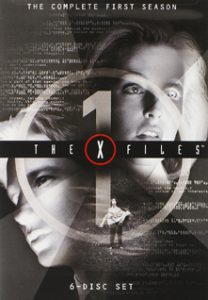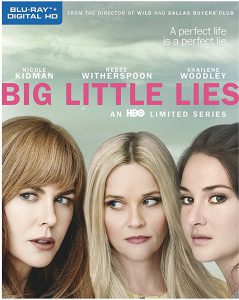“Big Little Lies” (which aired earlier this year on HBO, and can now be found on HBO Go or at Redbox) is the best thing I’ve seen from David E. Kelley, and also by far the most tolerable. Although I used to like “The Practice,” it grated on me after a while, and I didn’t make the switch over to the by-all-accounts even-crazier spinoff “Boston Legal.” But this miniseries is only seven episodes long, the perfect length for a viewer to appreciate the Kelley trappings before they overstay their welcome.
Perhaps the most Kelley-ian moment occurs early on when husband and wife Perry (Alexander Skarsgard) and Celeste (Nicole Kidman) are having a minor disagreement about their kids’ schooling and he suddenly attacks her. I laughed out loud at how cartoonish it looked, but going forward, Perry’s abuse – and broken relationships, and violence in general – become central to the show, and he got under my skin as a creepily unhinged villain. Kelley’s work sometimes feels forced on a viewer, but here he works with style-oriented director Jean-Marc Vallee and an all-star cast, and the disparate ingredients work well together.
Vallee favors too-dark imagery – where you can make out the faces because they glow when the scant light finds them — in the most fraught and pivotal scenes. The most notable one bookends the series: a crime scene with flashing police lights, coming on the heels of a Trivia Night fundraiser party at the Monterey, Calif., grade school. The flashbacks to a traumatic night in Jane’s (Shailene Woodley) past are also striking, as she runs along a beach after shoe prints that disappear. Some scenes, even with people energetically talking, are silent. At other times, quiet moments are interrupted by loud bangs.
The structure – built off the novel by Liane Moriarty – hooked me right away. It’s a murder mystery, but in addition to not knowing who the culprit is, we don’t know who the victim is. And in episode one, we get another puzzle: Which classmate choked Amabella, the daughter of Renata (Laura Dern), the woman who is the envy of all the other first-grade moms?
“BLL” isn’t about finding clues amid the plot, but rather finding clues in the characters’ behavior. Who would want to kill whom? Who would be capable of killing whom? Everyone has violence in them, even the 6-year-olds – which is a delicate topic, but it’s handled with a deft touch, particularly in the way the moms show love to their kids even as they suspect they might be capable of violence.
I think the best performance comes from Reese Witherspoon as Madeline. Like every mother on the series, she’s in danger of coming off as self-centered and phony, but Witherspoon brings an understated vulnerability to this woman who might be botching her second marriage, to the patient Ed (“Parks and Recreation’s” Adam Scott). Rounding out the trio of moms, Celeste is the classy woman with a secret that she never reveals to her friends, and Jane is the newcomer-to-town who fairly soon tells Madeline and Celeste that her son Ziggy is the product of a rape.

Even as we mull over how this puzzle might fit together, we get bizarre Kelley-esque side trips (and head trips), such as Madeline’s youngest daughter’s love of old pop standards and her oldest daughter’s “secret project.”
The men – including Jeffrey Nordling (“Once and Again”) as Renata’s husband and James Tupper as Madeline’s ex – also get good development, but as I recount the show, it’s clear it’s focused on the women. “BLL” is not just for women, although I’ve heard that some people believe women are the intended audience; it’s for anyone who enjoys a good yarn.
It leaves a few things frustratingly unanswered. The villain seems to have two names, and I would’ve liked to know more about his backstory. There are contrivances: How do the teachers in this school, with all the strict rules you’d expect in 2017, never see who is bullying Amabella? But it does answer the big ones in episode seven, and in fairly satisfying ways.
It’s also a rather beautiful show, with the aforementioned Vallee touches, plus the simple fact that it’s set on the California coast, with its sunsets and expensive houses. We get a very clear sense of the stratification as we range from Renata’s palatial estate down to Jane’s apartment, where she sleeps in the living room so Ziggy can have the one bedroom.
Each episode suggests a depth of feeling with the opening theme, Michael Kiwanuka’s “Cold Little Heart,” a gorgeous blues-pop number with pained, longing lyrics. And it ends with a pop standard – a cover of the Rolling Stones’ “You Can’t Always Get What You Want,” for instance – that jarringly propels us into the credits. Watching “BLL,” I was always a bit on edge. But I simultaneously wanted to find out what happens next (common when Kelley is on his game) and to wallow in the lives of these non-cartoon people (which is less common for a Kelley project). A beautiful portrayal of ugly lives, “BLL” ultimately earns its pairing with “Cold Little Heart.”

